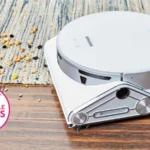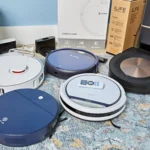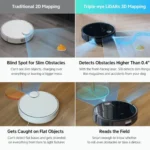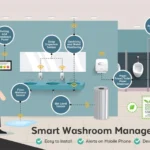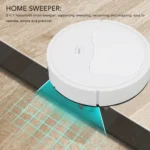Have you ever found yourself frustrated with the short battery life of your smart vacuum cleaner? With the rise of smart home technology, there are now several ways to manage and control your devices, including your vacuum cleaner’s battery life. Smart home integration is the key to unlocking the full potential of your smart vacuum cleaner, allowing you to control and monitor its battery life with ease. In this article, we will delve into the various methods for managing your smart vacuum cleaner’s battery, as well as explore how smart home integration can enhance your overall cleaning experience.
What is Smart Home Integration?
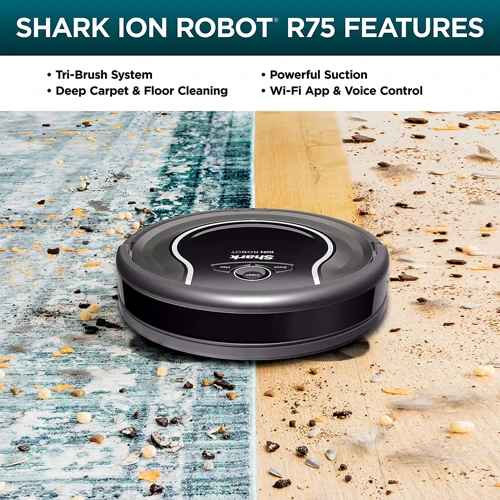
Smart homes are becoming increasingly popular today. With the advancement of technology, we can connect home devices to the internet for seamless automation and optimal efficiency. So what exactly is smart home integration? It’s the process of connecting and controlling various smart devices in your home, such as security systems, thermostats, lights, and even your smart vacuum cleaner through a central hub or network. This enables you to manage and monitor your home devices in real-time, making life easier and more convenient. As smart technology continues to evolve, we can now use it to extend our smart vacuum’s battery life, use the latest vacuum charging advancements, opt for fast charging, and ensure safe smart vac battery storage. You can read more about these options by visiting the internal link to extend your smart vacuum battery life.
Connecting Home Devices
When it comes to Smart Home Integration, connecting your devices is a crucial step to enjoy a seamless experience. Connecting home devices refers to linking all of your smart devices together so that they work together in a harmonious manner. This will ensure that you don’t have to manually operate each device, but instead, you can control them all from a single hub.
One of the key benefits of smart home integration is that it enables you to control various devices using a single platform. This means that you won’t have to use separate apps to operate your different smart home devices. For instance, you can control your smart vacuum cleaner, smart thermostat, and smart lighting via a single mobile app.
To connect your smart vacuum cleaner, you’ll need to ensure that the device is compatible with your smart home system. The compatibility details should be readily available in the device manual or manufacturer’s website. Fast-charging smart vacuums like the latest models can be easily integrated with your smart home ecosystem, allowing you to enjoy a seamless experience.
When connecting your smart vacuum cleaner, it’s also essential to ensure that you have the latest firmware updates installed. This will ensure that your device runs smoothly and that any bugs have been fixed. It’s essential to use a reliable home network to ensure that the smart vacuum cleaner can communicate effectively with other connected devices.
For safe smart vacuum battery storage, it’s advisable to keep the vacuum cleaner charging dock in a safe and secure location. You can place it in a designated charging station or keep it out of reach from children and pets. This will help protect the device’s battery lifespan and prevent any accidents.
Connecting your smart devices is a crucial step in enjoying a seamless smart home experience. It’s important to choose compatible devices, update the firmware, and choose a reliable home network. By following these best practices, you can ensure that your smart vacuum cleaner operates optimally and doesn’t drain the battery unnecessarily.
Benefits of Smart Home Integration
Smart home integration offers a multitude of benefits to users, including:
- Convenience – With smart home integration, you can control your home devices, including your smart vacuum cleaner, with just a few clicks or voice commands. You can schedule cleanings, monitor battery life, and receive alerts about maintenance needs right from your phone or smart assistant, without ever having to leave your couch.
- Energy Efficiency – By using a smart vacuum in conjunction with your smart home hub or assistant, you can program your device to only run during certain hours, optimizing energy usage and saving you money on your energy bill.
- Enhanced Performance – Smart vacuums can be programmed to clean based on your preferences and usage patterns, ensuring that your floors stay clean without overworking the device. Additionally, some smart vacuums can even detect and avoid obstacles automatically, saving you time and hassle.
- Safety – Smart vacuums are equipped with advanced sensors that can prevent them from falling down stairs, getting stuck under furniture, and more. Plus, when integrated with your smart home system, you can receive alerts if a problem arises, such as a low battery or a clogged filter.
- Cost Savings – The latest vacuum charger advancements and battery technologies enable fast-charging for your smart vacuum. You can safely store your smart vacuum in safe battery storage when not in use. This extends your battery life and helps you in saving money on annual battery replacements, as well as conserving energy usage.
The integration of smart home technology with your smart vacuum cleaner can greatly enhance your cleaning experience, helping you to save time, energy, and money while maintaining a clean and safe home environment.
Smart Vacuum Cleaner Battery Life Management
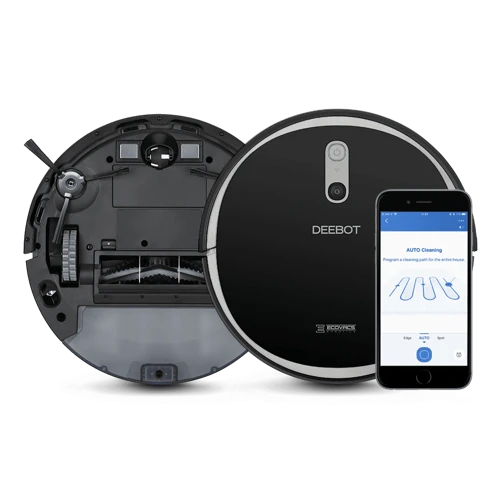
Keeping your smart vacuum cleaner powered up is crucial to maintaining a clean and tidy home, but managing its battery life can be a cumbersome task. Fortunately, there are various techniques and tools that can help you make the most out of your vacuum’s battery. In this section, we will explore different strategies to manage the battery life of your smart vacuum cleaner. From rechargeable batteries to battery life monitoring, we will cover everything you need to know to keep your smart vacuum’s power supply in top condition. So whether you’re tired of running out of juice in the middle of a cleaning session or simply want to ensure that your vacuum is always ready to go, read on to learn about the best practices for managing your smart vacuum cleaner’s battery life.
Rechargeable Battery
Smart vacuum cleaners come with a rechargeable battery that allows them to function wirelessly. Rechargeable battery technology has come a long way in recent years with the latest advancements offering a longer life, faster charging, and more reliable performance. When it comes to managing your smart vacuum cleaner’s battery life, here are some things to keep in mind:
- Choose a vacuum with a high-quality rechargeable battery: Look for a vacuum with a lithium-ion battery rather than the older nickel-cadmium models, as they provide more power and last longer. Additionally, some models feature removable batteries that can be easily swapped out, allowing you to always have a charged battery ready.
- Be mindful of charging times: Most smart vacuum cleaners come with a charging dock that the device must be placed on to recharge. It’s important to follow the manufacturer’s recommendation for how long to leave the vacuum on the dock. If you leave it charging for too long, you risk damaging the battery’s lifespan. To avoid this, consider investing in a fast-charging smart vacuum. These vacuums have advanced charging technology that allows them to fully charge in just a few hours.
- Maximize battery performance: Try to use your vacuum on a higher power setting for shorter periods of time, rather than using it on a low power setting for prolonged periods. This not only ensures a more efficient clean, but it also conserves battery power.
Following these tips will help you get the most out of your smart vacuum cleaner’s rechargeable battery. If you’re in the market for a new vacuum, be sure to do some research on the latest vacuum charger advancements and fast charging smart vacuums.
Charging Dock
Smart vacuum cleaners are known for their ability to make life easier by cleaning and maintaining floors within a few simple steps. However, all smart devices require energy to function optimally, and that is where charging docks come in. A charging dock is an essential component of smart vacuum cleaner battery life management, and it is essential to ensure that it is functional and efficient.
A charging dock works by providing an interface between the device and a power outlet to charge the smart vacuum cleaner’s battery. The device is positioned on the dock, and the battery is charged via electrical contact points. Modern charging docks tend to come with improved features, such as fast charging, auto shut-off, and overcharge protection mechanisms, making them more efficient than previous models.
It is important to note that for a charging dock to work effectively, the device’s charging port must be clean and in good condition. Regular cleaning of the charging port helps ensure that it is functional, and regular maintenance of the charging dock helps ensure it continues to function over time.
Below is a table highlighting some of the essential aspects of charging docks that a user should consider when looking for a charging dock for their smart vacuum cleaner:
| Aspect | Description |
|---|---|
| Compatibility | The charging dock should be compatible with the smart vacuum cleaner for optimal performance |
| Power Input | The power input should match the device’s requirements for efficient charging |
| Fast Charging | The charging dock should support fast charging for optimal performance. Check out latest fast charging smart vacuum dock news. |
| Auto Shut-off | The dock should have an auto shut-off feature that helps prevent overcharging, ensuring your device lasts longer |
| Charge Indicator | The charging dock should have a visible light indicator to show when the device is charging or fully charged |
| Design and Durability | The charging dock should have a durable design that provides safety and stability to the device while it charges |
Investing in the right charging dock for your smart vacuum cleaner is essential to optimize your device’s performance and the lifespan of the battery. It is also essential to research the latest vacuum charger advancements to ensure that you are buying the latest and most efficient model. By taking care of your charging dock, you can ensure that your device always has sufficient power for efficient cleaning.
Battery Life Monitoring
As with any battery-powered device, managing the battery life of your smart vacuum cleaner is crucial to its performance and longevity. Battery life monitoring is an important aspect of this management. Here are some tips to help you keep track of your smart vacuum cleaner’s battery life:
- Check the battery level: Most smart vacuum cleaners have a display or indicator that shows the current battery level. Check this regularly to ensure you don’t run out of battery mid-clean.
- Use the mobile app: Many smart vacuum cleaners come with a companion mobile app that allows you to monitor the battery life remotely. Use this feature to keep an eye on the battery level and get notifications when it’s time to charge.
- Set up routines: Most smart home assistants, like Amazon Alexa or Google Assistant, allow you to set up routines that can automate many tasks in your home. You can set routines to notify you when your vacuum cleaner’s battery level drops below a certain threshold or to automatically start charging the vacuum when the battery is low.
- Use a charging dock: Many smart vacuum cleaners come with a charging dock that keeps the vacuum charged and ready to go at all times. Make sure to place the dock in a convenient and accessible spot so your vacuum can easily dock and recharge when needed.
By monitoring your smart vacuum cleaner’s battery life, you can ensure that it always has enough power to clean your home effectively. With advancements in charger technology, such as wireless charging becoming more common, keeping your vacuum charged and ready to go has never been easier.
Battery Replacement
As much as we try to prolong the battery life of our smart vacuum cleaners, there will come a time when the batteries will need to be replaced. It’s important to note that replacing a battery may not be as simple as just popping in a new one. Here are some things to keep in mind when it comes to battery replacement:
- Identify the right battery: Not all vacuum cleaner batteries are created equal. Make sure to check the make and model of your smart vacuum cleaner and find the appropriate replacement battery. The wrong battery can damage your device or even cause safety hazards.
- Follow safety precautions: Before removing the old battery, make sure to turn off and unplug the vacuum cleaner. Wear gloves and safety glasses to protect yourself from any potential accidents. It’s also important to dispose of the old battery properly.
- Consider professional help: If you’re not confident in your ability to replace the battery yourself, it’s always better to seek professional help. Look for authorized service centers or technicians who can do the job properly.
- Recalibrate the battery: Once you’ve replaced the battery, you need to recalibrate it to ensure that it’s functioning properly. Refer to the manufacturer’s instructions on how to do this, as it may vary depending on the device.
Remember that proper maintenance and care can help extend the life of your smart vacuum cleaner’s battery, but eventually, it will need replacement. Don’t put it off, as a faulty or dead battery can cause damage to the device or even pose a safety risk.
Controlling Your Smart Vacuum Cleaner’s Battery Life with Smart Home Integration
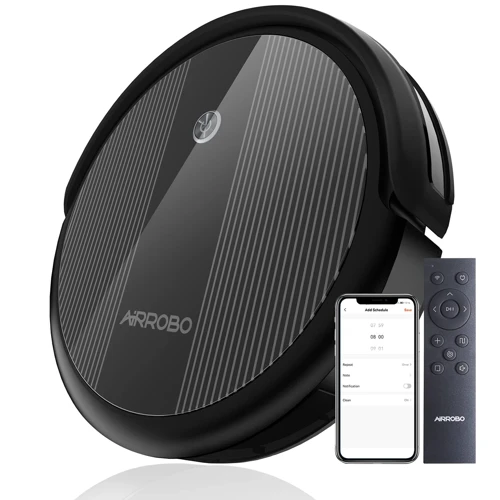
Are you tired of constantly monitoring and manually charging your smart vacuum cleaner’s battery? Luckily, with the power of smart home integration, you can easily control and manage your vacuum cleaner’s battery life in a more efficient and convenient way. By utilizing the latest technology, you can now give voice commands and access the vacuum’s settings through a mobile app. Keep reading to discover the many benefits of smart home integration for managing your smart vacuum cleaner’s battery life.
Smart Assistant Voice Commands
One of the most convenient ways to control your smart vacuum cleaner’s battery life is through the use of smart assistant voice commands. With just a spoken phrase, you can easily check the battery level and issue commands to recharge the battery or send the vacuum back to its charging dock.
Here are some examples of voice commands that can help you manage your smart vacuum cleaner’s battery life:
- “Hey [smart assistant name], how is the battery life on my vacuum cleaner? “ – This command allows you to check the remaining battery life and determine if it needs to be recharged.
- “Hey [smart assistant name], send my vacuum cleaner back to its charging dock.” – This command instructs the vacuum cleaner to return to its charging dock and recharge the battery.
- “Hey [smart assistant name], start cleaning and make sure the battery is fully charged.” – This command initiates the cleaning process and ensures that the vacuum cleaner’s battery is fully charged before beginning the cleaning cycle, prolonging the battery life.
- “Hey [smart assistant name], remind me to replace the vacuum cleaner’s battery in six months.” – With this command, you can set a reminder to replace the vacuum cleaner’s battery, ensuring that it remains in optimal condition.
It’s important to note that not all smart vacuum cleaners are compatible with smart assistant voice commands, so it’s important to check for compatibility before purchasing a device. Additionally, it’s important to keep your smart assistant and vacuum cleaner firmware updated and secure your network to protect your privacy and data. By following these smart home integration tips and best practices, you can ensure that your smart vacuum cleaner remains a valuable and reliable addition to your smart home ecosystem.
Mobile App Control
One of the best ways to control your smart vacuum cleaner’s battery life is through mobile app control. With your smartphone, you can easily manage your vacuum’s settings, monitor the battery life, and receive notifications when it’s time to charge or replace the battery.
Some popular mobile apps for smart home integration include the Amazon Alexa app, Google Home app, and the iRobot HOME app. These apps allow you to connect and control all your smart home devices in one place.
To control your smart vacuum cleaner’s battery life using a mobile app, follow these simple steps:
Step 1: Download the Mobile App
Download the corresponding mobile app for your smart vacuum cleaner from the App Store or Google Play Store. Install it on your smartphone and create an account if required.
Step 2: Connect Your Vacuum Cleaner
Ensure that your vacuum cleaner is connected to Wi-Fi and follow the instructions in the app to connect the smart vacuum cleaner to the mobile app.
Step 3: Set Up Battery Monitoring
From the mobile app, set up the battery monitoring settings to receive notifications when the battery level is low. You can also check the battery level through the app at any time.
Step 4: Set Up Cleaning Schedules
Many mobile apps allow you to set up cleaning schedules for your smart vacuum cleaner. By doing this, you can ensure that your vacuum cleaner is not running out of battery by scheduling cleanings when the battery is fully charged.
Step 5: Control the Settings
The mobile app gives you control over the settings of your smart vacuum cleaner. You can control the suction power, cleaning mode, and other settings directly from the app.
By using the mobile app control for your smart vacuum cleaner, you can have full control over your vacuum cleaner’s battery life to ensure that it is always charged and ready to use. Additionally, mobile app control provides added convenience by allowing you to control your vacuum cleaner remotely from your smartphone.
Smart Home Integration Tips and Best Practices
As smart home integration becomes more prevalent, it’s important to stay up to date with the latest tips and best practices to ensure a seamless and secure experience. Whether you’re a seasoned pro or just starting out, there are strategies you can implement to make the most of your smart home devices. In this section, we’ll explore some top tips for smart home integration and best practices for managing your devices. Let’s dive in!
Choose Compatible Devices
When setting up your smart home integration, it’s important to choose compatible devices that work seamlessly with each other. Compatibility is key when it comes to avoiding frustration and ensuring that your devices function optimally.
To help you choose compatible devices, here are some tips to keep in mind:
- Research before you buy: Before purchasing a new smart home device, do your research to make sure it’s compatible with your existing devices and smart home hub.
- Check the standards: Look for devices that follow industry standards such as ZigBee, Z-Wave, or Wi-Fi Alliance to ensure compatibility.
- Stick to one brand: If possible, stick to one smart home brand to increase compatibility and simplify your setup.
- Avoid proprietary technology: Avoid devices that use proprietary technology as they may not work with other devices that use different technology.
By choosing compatible devices, you’ll ensure that your smart home integration runs smoothly and effectively. Don’t rush into buying a new device without researching if it is compatible. It is better to take time and find a compatible device rather than making a purchase that will give you headaches.
Update Device Firmware
Keeping your smart vacuum cleaner’s firmware up-to-date is important to ensure that it functions properly and efficiently. It’s also critical for the security of your connected devices. Here are some tips for updating your device firmware:
- Regularly Check for Updates: Most smart vacuum cleaner manufacturers release firmware updates regularly. Check your device’s manual or the manufacturer’s website to find out how to check for updates. Some devices may automatically apply firmware updates when they are available.
- Follow Update Instructions: Make sure you follow the manufacturer’s instructions when installing firmware updates. Skipping any steps or interrupting the process can cause errors and even permanently damage your device.
- Use a Stable Internet Connection: Firmware updates require a stable and reliable internet connection. Avoid updating your device during times of poor connectivity or during a storm.
- Back Up Your Data: Before updating your smart vacuum cleaner’s firmware, back up any important data or settings to ensure you don’t lose anything in the process.
- Check for Known Issues: Check the manufacturer’s website or community forums for any known issues with the latest firmware update. Doing so can help you avoid any potential bugs or malfunctions.
Updating your smart vacuum cleaner’s firmware is a vital part of keeping your device functioning properly and enhancing your smart home integration experience. Don’t forget to regularly check for updates, carefully follow the manufacturer’s instructions, and take necessary precautions before updating your device.
Set Up Routines and Automations
One of the best ways to improve the battery life of your smart vacuum cleaner is by setting up routines and automations. This means you can automate the cleaning process and ensure that your smart vacuum cleaner only uses its battery as efficiently as possible. Here are some ways to set up routines and automations for your smart vacuum cleaner:
- Schedule cleaning times: One of the easiest ways to save battery life is to only run the smart vacuum cleaner when necessary. By scheduling cleaning times, you can ensure that the smart vacuum cleaner only runs when you want it to. This not only saves battery life but also ensures that the vacuum cleaner is only cleaning when it needs to.
- Limit cleaning area: Another way to save battery life is to limit the areas that your smart vacuum cleaner cleans. You can set up virtual boundaries in your home to ensure that the smart vacuum cleaner only cleans the areas that need it. This saves battery life by not having the vacuum cleaner clean unnecessary areas.
- Use motion sensors: Motion sensors can be installed throughout your home to detect when the smart vacuum cleaner needs to clean. When the sensor detects movement, it can trigger the smart vacuum cleaner to start cleaning. This saves battery life by ensuring that the vacuum cleaner only runs when necessary.
- Pair with other smart devices: Pairing your smart vacuum cleaner with other smart devices can help improve battery life. For example, if you have a smart door lock, you can set up a routine that triggers the vacuum cleaner to start cleaning when the door is locked. This saves battery life by ensuring that the vacuum cleaner only runs when you are out of the house.
By setting up routines and automations for your smart vacuum cleaner, you can ensure that it only uses its battery when it needs to. Not only does this save battery life, but it also ensures that the vacuum cleaner is operating efficiently. Be creative with the routines and automations you set up to get the most out of your smart home integration.
Check Compatibility with Your Smart Home Hub
When it comes to integrating your smart home devices, checking compatibility with your smart home hub is crucial. Not all devices are designed to work seamlessly with all hubs. Here are some important factors to consider when checking compatibility:
- Device Protocol: Make sure the device uses a protocol that is compatible with your smart home hub. The most common protocols are Zigbee, Z-Wave, and Wi-Fi. Some hubs may only support one or two of these protocols, so be sure to check your hub’s specifications.
- Hub Requirements: Check the hub’s requirements for device connectivity. Some hubs may only support a certain number of devices, while others may require specific firmware versions to be installed on the devices.
- Manufacturer Recommendations: It’s always a good idea to check the device manufacturer’s website for any recommendations or compatibility information. They may have specific instructions for how to successfully integrate the device with your smart home hub.
- Third-Party Apps: If you plan on using a third-party app to control your devices, make sure it is compatible with your smart home hub. Some apps may only work with specific hubs or protocols.
By taking the time to check compatibility with your smart home hub, you can ensure that your smart vacuum cleaner and other devices work seamlessly together. This will help you to better manage your smart vacuum cleaner’s battery life and ensure that it is always charged and ready to clean when you need it.
Secure Your Network
Protecting your smart home devices and network is crucial for ensuring the security of your personal information and preventing unauthorized access. Here are some practical tips for securing your network:
| Tip | Description |
|---|---|
| Change Default Passwords | Many devices come with default usernames and passwords that are easy to guess. For optimal security, change these to strong, unique passwords. |
| Use Strong Encryption | Ensure that your Wi-Fi network uses WPA2 encryption with AES encryption algorithm. This helps prevent unauthorized access to your network. |
| Enable Two-Factor Authentication | Two-factor authentication adds an extra layer of security to your smart home devices by requiring a second form of authentication, such as a security token or biometric data. |
| Limit Access to Your Network | Only allow trusted devices to connect to your Wi-Fi network, and regularly monitor your network for any unauthorized access attempts. |
| Regularly Update Firmware | Manufacturers often release firmware updates to address vulnerabilities and introduce new features. Regularly update your devices’ firmware to strengthen their security. |
| Use a VPN | Virtual Private Networks (VPNs) encrypt your internet traffic, making it more difficult for hackers to intercept and steal your personal information. |
By following these best practices, you can greatly reduce the risk of your smart home devices being hacked or compromised. Remember to always stay vigilant and keep your devices and network up to date with the latest security updates.
Conclusion
In conclusion, smart home integration has revolutionized the way we control our home devices, and managing the battery life of our smart vacuum cleaner has never been easier. By utilizing the various methods outlined in this article, like rechargeable batteries, charging docks, battery life monitoring, and battery replacements, we can ensure that our vacuum cleaner is always powered up and ready to clean.
Through the latest advancements in smart home technology, we can also control our smart vacuum cleaner’s battery life using smart assistant voice commands and mobile app control. These features allow us to effortlessly monitor and manage our vacuum cleaner’s energy consumption, ensuring that our device lasts longer and performs better.
When it comes to smart home integration, it’s crucial to choose compatible devices, update firmware regularly, and set up routines and automations to optimize the performance and longevity of our smart home devices. Before purchasing any smart home device, it’s essential to check compatibility with your smart home hub and secure your network to prevent any potential cyber-attacks.
Overall, with the help of smart home integration, we can enjoy a more convenient, comfortable and energy-efficient home. So, invest in smart home technology, follow the best practices outlined in this article, and take control of your smart vacuum cleaner’s battery life with ease.
Frequently Asked Questions
What is the average battery life of a smart vacuum cleaner?
The average battery life of a smart vacuum cleaner is around 60-90 minutes.
Can I replace the battery in my smart vacuum cleaner?
Yes, most smart vacuum cleaners have replaceable batteries that can easily be swapped out when needed.
How do I know when my smart vacuum cleaner’s battery needs to be replaced?
You’ll notice a decrease in the vacuum’s cleaning power and the battery may not last as long as it once did when it needs to be replaced.
What is a charging dock and how does it work?
A charging dock is a device that the smart vacuum cleaner docks itself on when it needs to recharge. It works by providing power to the vacuum’s internal rechargeable battery.
Can I control my smart vacuum cleaner’s battery with a mobile app?
Yes, many smart vacuum cleaners come with mobile apps that provide information about the battery life and allow you to control the vacuum’s charging schedule.
How can smart home integration benefit me?
Smart home integration allows you to control and automate many devices within your home, making your life easier and more convenient. It can also save you time and money on energy bills.
What is the most important thing to consider when choosing a smart home hub?
Compatibility with your other smart home devices is the most important thing to consider when choosing a smart home hub.
Can I use smart assistant voice commands to control my smart vacuum cleaner’s battery?
Yes, most smart vacuum cleaners can be controlled with smart assistant voice commands such as those from Amazon Alexa or Google Assistant.
How often should I update my smart vacuum cleaner’s firmware?
It’s a good idea to check for firmware updates regularly and update your smart vacuum cleaner as needed, to ensure that it’s working at peak performance.
Is it important to secure my smart home network?
Yes, securing your smart home network is very important to protect your personal information and prevent malicious attacks on your network.

